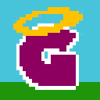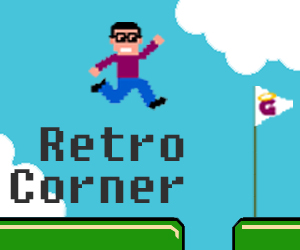 Game: Star Trek: 25th Anniversary (1992)
Game: Star Trek: 25th Anniversary (1992)
Developer: Interplay
Publisher: Interplay
Originally Released on: PC, Mac, Amiga
Currently Available on: Second-hand: eBay, etc.
The recent re-boot of the Star Trek film franchise by J.J. Abrams has opened up a whole new world of possibilities for the crew of the Starship Enterprise. To say that the original cast of William Shatner, Leonard Nimoy, et al had already had their time in the sun – and perhaps even outstayed their welcome a little as they got older – is certainly no over-statement. And by the time that the crew of The Next Generation took over the movie series, they were already past their prime too.
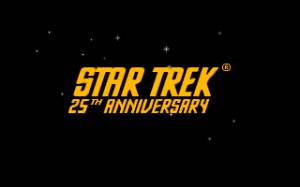 Things needed shaking up, and the man behind innovative television series LOST has somehow managed to re-imagine the iconic crew and bring them to a new audience – but at the same time without aggravating and alienating all of the enthusiastic long-term fans. So it is little surprise that this year both a sequel to the re-launched film, and an accompanying video game, will be released shortly. In this new game from Namco Bandai Games and Digital Extremes, players will get to control both Captain Kirk and Mr Spock in co-operative action. Whilst gamers wait for that title though – we at GodisaGeek.com will take you on a trip back in Retro Gaming history, to another Star Trek title that allowed gamers not only to control a full away team as they explored strange new planets and meet new species, but also to take part in some tense space combat too.
Things needed shaking up, and the man behind innovative television series LOST has somehow managed to re-imagine the iconic crew and bring them to a new audience – but at the same time without aggravating and alienating all of the enthusiastic long-term fans. So it is little surprise that this year both a sequel to the re-launched film, and an accompanying video game, will be released shortly. In this new game from Namco Bandai Games and Digital Extremes, players will get to control both Captain Kirk and Mr Spock in co-operative action. Whilst gamers wait for that title though – we at GodisaGeek.com will take you on a trip back in Retro Gaming history, to another Star Trek title that allowed gamers not only to control a full away team as they explored strange new planets and meet new species, but also to take part in some tense space combat too.
Interplay held the Star Trek license for most of the nineteen nineties, and is probably best known for some of its flight simulator and more action-orientated titles, but the first big hit that the company had in terms of Star Trek games – and probably the first critically successful Star Trek game from any publisher – was Star Trek: 25th Anniversary. Coming in 1992, the game celebrated twenty-five years since the start of the original TV show and, as such, featured the crew headed up by Captain Kirk.
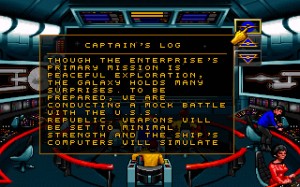 Now remember that this was before the time of the first-person shooter, and in the early nineties the point-and-click adventure game was still enjoying its golden age. What was inventive about this title, however, was that whilst the away missions in the game were played out like a traditional point and clicker, all of the ship-based action played like a flight simulator – including many space-based dogfights against Romulans, Klingons and the like. It was this combination of two distinct game styles that made the game stand out from others at the time, and also allowed the title to capture the spirit of the television series just that little bit better.
Now remember that this was before the time of the first-person shooter, and in the early nineties the point-and-click adventure game was still enjoying its golden age. What was inventive about this title, however, was that whilst the away missions in the game were played out like a traditional point and clicker, all of the ship-based action played like a flight simulator – including many space-based dogfights against Romulans, Klingons and the like. It was this combination of two distinct game styles that made the game stand out from others at the time, and also allowed the title to capture the spirit of the television series just that little bit better.
The game is split up into seven “episodes”, and takes the place of the never-filmed fourth series of the TV show – with each mission kicking off with a short Captain’s Log introduction by Captain Kirk – to introduce the objectives and events that will be focused on in that mission. The game sticks very closely to the little details such as this; in fact, Paramount had kept control of all of the final decisions as to what made it into the game or not, which therefore ensured that Interplay kept faithfully to what fans should expect from a Star Trek game. They went to town in that respect, making use of the entire cast for voice recording on the CD-Rom version of the game, and featuring authentic music taken directly from the TV show. This made the whole experience feel really immersive, and the game was great for Trek fans. It must be mentioned that the CD-Rom release also featured an extended – and superior – final mission, as well as a fitting tribute to Star Trek creator Gene Roddenberry.
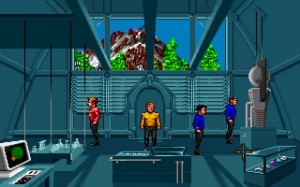 Each episode was very faithful to the show. They were all more or less standalone missions, as each television episode would have been – and, in each, the player would take control of Kirk, Spock, Dr McCoy and a red shirt ensign, on different away missions on alien planets or space stations, for instance. Most episodes would begin with the player plotting a course from the bridge of the enterprise, before having Scotty teleport your team to their destination.
Each episode was very faithful to the show. They were all more or less standalone missions, as each television episode would have been – and, in each, the player would take control of Kirk, Spock, Dr McCoy and a red shirt ensign, on different away missions on alien planets or space stations, for instance. Most episodes would begin with the player plotting a course from the bridge of the enterprise, before having Scotty teleport your team to their destination.
When on away missions, you can choose to control each individual character to carry out particular actions specific to their special abilities. For instance, Mr Spock can use his Tricorder to scan areas and objects, Dr McCoy can analyse chemicals or treat the wounded and the red shirt – well, you might use him when an element of danger is involved and you don’t want to risk anyone else! Paramount had insisted that if any main member of the crew should die on a mission, then the player would fail and have to re-try. But thankfully that didn’t extend to the famous red-shirt, no-name characters – whom you could allow to die, albeit with a negative effect on your overall mission rating. The mission rating would also take into account whether you killed or stunned your enemies, and any other mistakes you made – and also whether you completed optional extras, as there was often more than one way to complete each mission, with one way being preferable to others. There were actually several (albeit only slightly different) endings that you could arrive at, dependent on your mission scores, which – when combined with the alternate mission solutions – was quite inventive and unusual for the time.
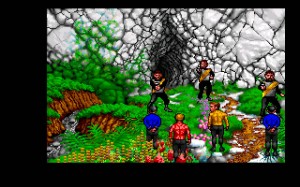 The stories all feature recognisable characters and races from the series – you will come face to face with Klingon warriors, space pirates and even Harry Mudd – a memorable personality from the TV show. All of this is great for fans, as the game is written in an authentic way, referencing lots of Star Trek insider knowledge and displaying the same sense of humour and banter that featured between the main characters on-screen. This makes the game a little more light-hearted as the themes of most of the missions are pretty serious in tone, such as disabling a centuries-old nuclear warhead, or stopping the spread of a new disease. These missions did all have a sense of urgency though, which added a little tension to proceedings, and many of the missions were-time related, so players couldn’t hang around and waste time.
The stories all feature recognisable characters and races from the series – you will come face to face with Klingon warriors, space pirates and even Harry Mudd – a memorable personality from the TV show. All of this is great for fans, as the game is written in an authentic way, referencing lots of Star Trek insider knowledge and displaying the same sense of humour and banter that featured between the main characters on-screen. This makes the game a little more light-hearted as the themes of most of the missions are pretty serious in tone, such as disabling a centuries-old nuclear warhead, or stopping the spread of a new disease. These missions did all have a sense of urgency though, which added a little tension to proceedings, and many of the missions were-time related, so players couldn’t hang around and waste time.
The other side of the coin in the game though was the space battles. Often, at the beginning or end of a mission, the crew of the Enterprise would arrive at a new destination only to encounter an unfriendly enemy spacecraft. The enemy would differ, depending on the mission, but the Enterprise would have to engage in a flight simulator fight with the other craft, or sometimes several spacecraft. Luckily the game developers saw fit to place a tutorial for this mode right at the beginning of the game – which plays out as a simulated training mission – and this greatly helps the player get used to the flying system. It is all quite intuitive, with the ship turning depending on the movement of the mouse cursor, and the two buttons firing either phasers of photon torpedoes.
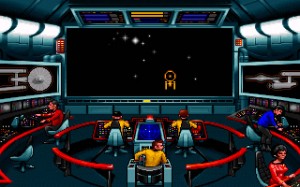 It became tricky when you also had to manage your shields, and divert power from other systems to repair the ship once you had begun to take damage – although the less action-orientated players out there could opt to let Scotty handle this side of things for you, making it slightly easier. But these fights were certainly not easy at all, with them getting harder as you progressed through the missions and the final boss fight being incredibly hard. It is regarded as quite an accomplishment if you managed to defeat the final battle, as you faced off against three ships at once, and one of them was hugely over-powered.
It became tricky when you also had to manage your shields, and divert power from other systems to repair the ship once you had begun to take damage – although the less action-orientated players out there could opt to let Scotty handle this side of things for you, making it slightly easier. But these fights were certainly not easy at all, with them getting harder as you progressed through the missions and the final boss fight being incredibly hard. It is regarded as quite an accomplishment if you managed to defeat the final battle, as you faced off against three ships at once, and one of them was hugely over-powered.
This did make the game a lot more challenging though, and certainly prolonged the life of the title, but this certainly wasn’t one for point and click fans who didn’t like action. Even the adventure-based missions sometimes needed quick reflexes on your phaser-trigger, in order to defeat your enemies so save early and save often – as is the famous adventure game prime directive – be it Star Trek or not.
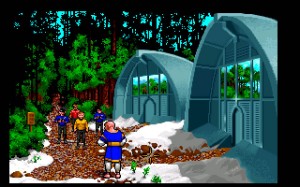 It must be said that the game was very ambitious for the time that it came out. Having two core gameplay systems allowed it to really re-create the feeling of being a member of the Enterprise crew, and added some great variety to gameplay. Different ways of completing missions, leading to multiple endings and scores was also quite a nice touch, which also made it fun to re-play missions, so you could either try to beat your score, or perhaps try to find all of the red shirt death sequences, for example! This was a fully authentic Star Trek title, and probably remained the strongest game from the franchise for years to come. Of course, that is along with its sequel Judgement Rites, which was just as good and allowed you to actually take control of Sulu, Uhura and Chekov on away missions too, and featured longer missions overall. This was a fitting way to mark the 25th Anniversary of the beloved Star Trek series, and the title remains extremely playable today. If you can track down the game somewhere in the universe this is absolutely worth your time, whether you be Trekker, Trekkie or neither.
It must be said that the game was very ambitious for the time that it came out. Having two core gameplay systems allowed it to really re-create the feeling of being a member of the Enterprise crew, and added some great variety to gameplay. Different ways of completing missions, leading to multiple endings and scores was also quite a nice touch, which also made it fun to re-play missions, so you could either try to beat your score, or perhaps try to find all of the red shirt death sequences, for example! This was a fully authentic Star Trek title, and probably remained the strongest game from the franchise for years to come. Of course, that is along with its sequel Judgement Rites, which was just as good and allowed you to actually take control of Sulu, Uhura and Chekov on away missions too, and featured longer missions overall. This was a fitting way to mark the 25th Anniversary of the beloved Star Trek series, and the title remains extremely playable today. If you can track down the game somewhere in the universe this is absolutely worth your time, whether you be Trekker, Trekkie or neither.
The new Star Trek game will be released by Namco Bandai on April 26. The God is a Geek Retro Corner will return on the first Friday of next month. You can see previous entries into the GodisaGeek Retro Corner by clicking here.


